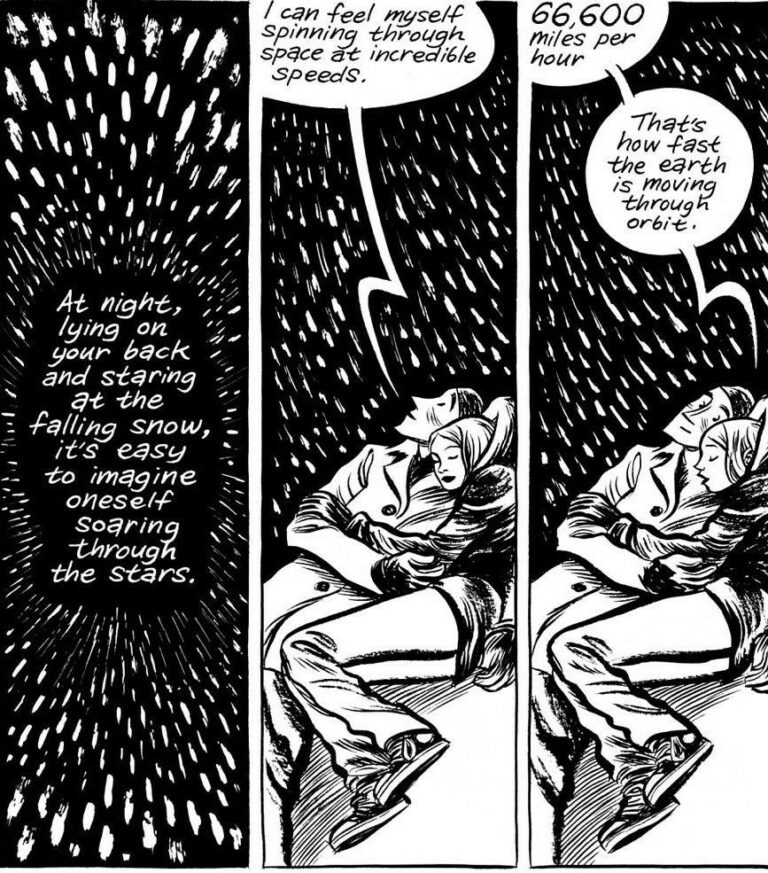
Reading a Classic
Do you know that feeling when a book or another piece of art is valued so highly by a certain group of people that one is almost hesitant to pick it up? It’s as if all the expectations or assumptions create a barrier to the work itself, at least that’s how it feels to me sometimes. This winter, I tried to leap over some of those gaps, first by reading the Sandman series by Neil Gaiman and, more recently, Blankets by Craig Thompson.
Blankets, which was originally published in 2003 by Top Shelf Productions to much critical acclaim is an autographic (an autobiographical graphic novel) about the artist’s childhood and adolescence in rural Wisconsin. The plot begins with the early years of Thompson and his younger brother Phil in the Christian community of their hometown, then gradually transforms into a romantic account of Thompson’s relationship with Raina, a girl he meets as a teenager at a ski camp. This relationship takes up most of the space of book and casts a warm light on the otherwise grim portrayal of the artist’s childhood, which is filled with bullying, depravity and religious doubt. In many ways, Blankets is a comic-turned-love-letter as it relates the meeting of the two misfits, Thompson and Raina, at a pivotal time in their lives, and how their relationship shifted their perspectives.
What struck me the most about Blankets is how it captures the intensity of falling in love for the first time. Romantic love as the subject of fiction is a tricky affair because it threatens to dissolve into cliché, into an emotional language that everyone knows, and no one really believes in. And while Blankets can get quite sentimental at times (perhaps even kitschy), it mostly feels like a highly personal story and reminded me of similar experiences I made as a teenager. The book somehow captures the force of those feelings, the proximity and long conversations that feel special precisely because they are experienced for the first time. It’s like stumbling upon a secret too big for words, like a written note from a crush that you kept tight in your sweaty palm when you were a kid.
As an autographic, Blankets lacks the complex meta-narrative of, say, the work of Alison Bechdel or Art Spiegelman. But that’s okay because the book brings the reader closer to the memories themselves instead of weaving them into a broader life story. Blankets zooms in on momentary feelings that constitute Thompson’s memories, from the way a kiss or a piece of fabric felt, to the view of a snowy sky from below.

Of course, the book mostly radiates these feelings because of its drawings: Thompson’s lines fly boldly across the page, rending characters and their faces in a highly expressive way. Bodies and objects seem to stretch or shrink with emotions of the characters, and ornamental imaginings of heaven and hell accompany renderings of childhood fantasy worlds.
The dynamic nature of Thompson’s art also applies to the composition of panels on the page. In an interview, cartoonist and theorist Scott McCloud elaborated on how Blankets was quite innovative for its time, and I can sense why. As with the drawings, the panels underline the characters’ emotions. Sometimes things seem to jump out of the images, sometimes they blend into each other as lovers embrace. Finally, the book is littered with skillfully placed blank spaces that act as pauses in the comic’s rhythm and say more than any image could. Thompson’s playful compositions still feel fresh 17 years later and it is not hard to see their influence on the work of other cartoonists. All in all, Blankets comic worthy of its renown and I will continue to recommend it to anyone who needs a story to get through the cold winter days.
Blankets
Craig Thompson
2003
Top Shelf